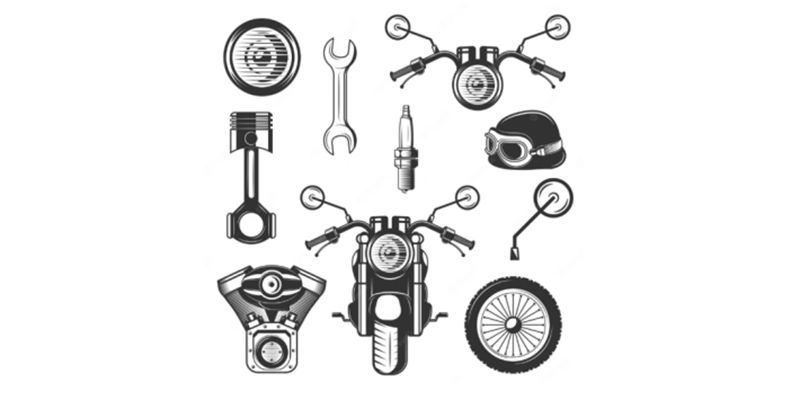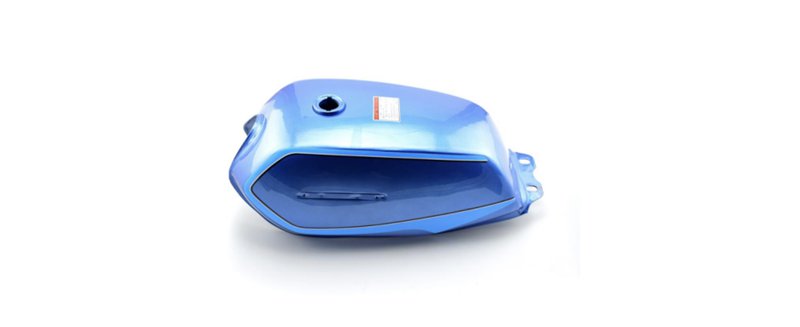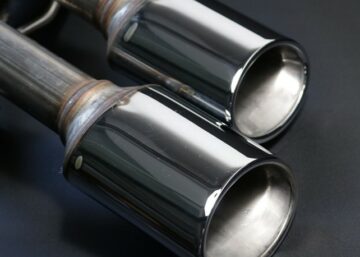The motorcycle part manufacturing industry relies largely on rapid prototyping and manufacturing processes to design and produce custom motorcycle parts. However, the quality of these parts depends on several factors, most centered on the choice of manufacturing/prototyping processes.
There is a need for motorcycle parts companies to understand the right choice of processes. As a result, this article will discuss 4 methods for prototyping and manufacturing parts on a motorcycle and other things that can affect the quality of the manufactured parts.
 CNC Machining Custom Motorcycle Parts
CNC Machining Custom Motorcycle Parts
CNC machining is the most common motorcycle parts manufacturing and prototyping process currently in the market. The subtractive process involves using computer-controlled machines to shape a workpiece according to a design using techniques such as turning, milling, and drilling.
This process is the appropriate method for producing motorcycle body parts from metals, plastics, and composite materials. It is also suitable for both prototyping and manufacturing, although motorcycle machine shops will prefer it for its real-time manufacturing process instead of prototyping.
Why Choose CNC Machining for Motorcycle Parts?
Businesses should consider CNC machining for making custom motorcycle accessories for the following reasons:
High Precision and Accuracy
Machining motorcycle parts is precise and accurate. As a result, it is highly suitable for components where errors in part dimensions can lead to significant issues. Furthermore, the precision ensures consistency and uniformity of parts during production.
Material compatibility
Aside from making precision motorcycle parts, CNC machining has high material compatibility. As a result, it is suitable for hard materials, whether plastics, metals, and some composite materials. Furthermore, manufacturers have a high degree of freedom when choosing materials, irrespective of motorcycle models and styles.
Efficiency
CNC machining is an efficient process that can produce custom motorcycle parts quickly, making it ideal for both one-off creations and small production runs. This efficiency helps reduce lead times and production costs.
Compatibility with complex geometries
Custom parts on a motorcycle come in different shapes and designs, necessitating a process compatible with complex geometries. CNC machines have the capability making it applicable in prototyping and manufacturing custom motorcycle frames, exhaust systems, and bodywork.
Motorcycle Parts Produced through CNC Machining
Common custom motorcycle accessories include:
- Brake disc rotors for the part’s heat dissipation and reduce the weight.
- Clip-on handlebars allow proper ergonomic alignment for the rider and the creation of aesthetic designs.
- Billet aluminum triple for front-end geometry customization, which enhances handling.
Sheet Metal Fabrication of Custom Motorcycle Parts
Sheet metal fabrication is applicable in motorcycle fabrication and comprises several techniques that allow you to turn thin sheet metals into final products.
It comprises several techniques and common ones in motorcycle fabrication, including laser and plasma cutting, suitable for thin and thick sheet metals and forming processes such as bending and stamping. Other sheet metal techniques are welding and riveting, which aid customization of motorcycle parts.
 Why Choose Sheet Metal Fabrication for Motorcycle Parts?
Why Choose Sheet Metal Fabrication for Motorcycle Parts?
The sheet metal fabrication process is pivotal in motorcycle fabrication due to the nature of the material and the uniqueness of the process:
Design Freedom
Sheet metal fabrication is a more flexible custom motorcycle part building suitable for different materials, including steel, aluminum, and titanium. Its flexibility allows the creation of unconventional and innovative parts, pushing the boundaries of motorcycle aesthetics.
Cost-effectiveness
Sheet metal fabrication is cost-effective for machine companies in mass-producing motorcycle parts. This is due to the process’ ability to process large sheet metal and its quick turnaround time. Furthermore, the quick turnaround reduces the production lead times, allowing businesses to meet their market demand efficiently.
Reduced Material Waste
Unlike other metal manufacturing processes, sheet metal fabrication generates little wastage. As a result, there is a reduction in the cost of purchasing materials and the effect on the environment.
Scalability
Sheet metal fabrication processes are highly scalable, making them suitable for producing small-scale custom parts and large quantities of standardized components for mass-produced motorcycles.
Motorcycle Parts Produced through Sheet Metal Fabrication
Common custom motorcycle accessories manufactured using sheet metal fabrication include:
- Sheet metal fabrication is suitable for creating gas tanks of different sizes and shapes.
- Fenders for custom motorcycle parts with both functional and aesthetic purposes.
- Body panels and covers.
3D Printing Custom Motorcycle Parts
3D printing or additive manufacturing is another computer-controlled process that involves creating the three-dimensional machine part by depositing successive layers of the working material (plastic or metal). It is suitable for prototyping and manufacturing custom accessories for motorcycles, although it is more common for making prototypes.
 Why Choose 3D Printing for Motorcycle Parts?
Why Choose 3D Printing for Motorcycle Parts?
In custom motorcycle body part production, 3D printing is a game changer for enthusiasts who need unique and personalized motorcycle components.
Design Complexity
3D printing is arguably the most suitable process for complex motorcycle fabrication. The process is highly flexible and accurate, and the layering technique allows the creation of intricate and complex designs, which is impossible to achieve using traditional manufacturing methods.
Rapid Prototyping
The motorcycle part manufacturing industry requires the creation of prototypes for testing due to safety. 3D printing is the most suitable method for prototyping, especially during the trial-and-error stage, as designers can quickly iterate and refine their designs without wasting time and materials.
Lightweight Materials
3D printing, due to the layering technique, allows the creation of hollow parts easily, making it suitable for making parts that encourage reduced fuel usage. Furthermore, it is compatible with lightweight materials such as carbon fiber-reinforced plastics, which improves the overall weight distribution.
Cost-efficiency
Excluding its high initial investment, 3D printing is a cost-efficient option in motorcycle part manufacturing compared to other methods.
 Motorcycle Parts Produced through 3D Printing
Motorcycle Parts Produced through 3D Printing
Common custom motorcycle prototype parts made using 3D printing include custom air intake covers with intricate designs, 3D-printed brackets and mounts to house lights and mirrors, and 3D-printed chain guards to protect riders from debris. However, these 3D products usually are used for testing and validation.
Injection Molding Custom Motorcycle Parts
Injection molding involves injecting melted plastic into a pre-designed mold cavity and allowing it to solidify into the desired shape. It is primarily used for producing motorcycle plastic products and is cost-effective, repeatable, and versatile.
Why Choose Injection Molding for Motorcycle Parts?
Injection molding in motorcycle fabrication is widely popular due to several reasons:
Mass Production
Injection molding is one of the few motorcycle part-building processes that supports mass production. It is cost-effective when producing large quantities of identical parts. Once a mold, subsequent parts can be manufactured with reduced per-unit costs.
Consistency and Precision
There is high consistency and precision when working with injection molding. As a result, each part is identical to the other. This is highly important in critical components that are assembled after production.
Suitable for Small Non-structural Components
Injection molding is ideal for parts that require high customization as structural components. These include handlebar grips, signal lenses, and airbox covers. Their cost-effectiveness allows the manufacture of these parts for resale to a broader market.
Quick Turnaround
Once the mold is ready, the injection molding process is fast, with cycle times typically ranging from seconds to minutes. This quick turnaround is advantageous when meeting tight project deadlines.
 Common Motorcycle Parts Produced through Injection Molding
Common Motorcycle Parts Produced through Injection Molding
Injection molding is applicable in making the following motorcycle body parts.
- Fairings and exceptional quality body panels.
- Switch housings made using injection molding function in housing the electrical controls and switches are durable and weather-resistant.
- Side covers and cowls protect the engine and other components.
How to Choose the Right Manufacturing Process for Custom Motorcycle Parts?
Choosing the right manufacturing process for custom motorcycle building is critical in the part quality, lead time, production cost, and motorcycle performance. Here are a few things to make an informed decision:
Parts Complexity
When working with custom motorcycle parts with intricate details and complex designs, CNC machining, and 3D printing are common choices because they can create complex geometries. For simple parts, injection molding or sheet metal fabrication is better.
Materials
Aside from deciding the performance and aesthetics of custom motorcycle parts, the choice of material also determines the manufacturing process. CNC machining and 3D printing are compatible with a wide range of materials. However, injection molding and sheet metal fabrication are suitable for plastics and metals, respectively.
Volume and Production Quantity
3D printing and CNC machining are the best options for low-volume motorcycle fabrication. However, injection molding and sheet metal fabrication are more economical for high-volume production.
Cost of Machine
The cost of machines can also determine the cost of custom motorcycle building. Most businesses in motorcycle part building outsource their project to rapid prototyping and manufacturing services due to the need to avoid the high investment cost and still have access to numerous machines.
Surface Finish and Aesthetics
Some manufacturing process does not need surface finishing after the production process. Examples include injection molding and CNC machining with excellent surface finish. Others might require additional post-processing steps.
Materials Used for Manufacturing Motorcycle Parts
Businesses should consider the choice of material for making custom motorcycle parts as it directly affects the car parts’ performance, safety, and overall quality. Common materials used include:
 Aluminum
Aluminum
Aluminum has a high strength-to-weight ratio, heat dissipation, and corrosion resistance. As a result, it has reduced fuel consumption and carbon footprint. It applies to motorcycle body parts that require high structural integrity, such as frames, swingarms, engine covers, and triple clamps.
Stainless Steel
Stainless steel is another common material for motorcycle parts due to its durability, corrosion resistance, and strength. It is applicable in making structural parts on a motorcycle, such as body frames and other components, such as exhaust systems, brackets, and fasteners.
Titanium
Titanium is corrosion resistant, has high strength, and exceptional heat resistance. As a result, parts on a motorcycle made with the material can withstand heavy loads and impacts, be used in harsh environments, and withstand high temperatures. Nevertheless, it has limited use due to its high cost.
Carbon Fiber Composites
Carbon fiber composites are lightweight, high-strength materials for crafting parts on a motorcycle, such as fairings, frames, swingarms, and exhaust systems. Its high strength-to-weight ratio reduces overall bike weight while maintaining structural integrity and reducing fuel consumption. Furthermore, it is more versatile and suitable for aerodynamic designs, reduces vibrations, and enhances rider comfort.
Plastic and Polymers
Plastic and polymer materials such as ABS (Acrylonitrile Butadiene Styrene) and PVC (Polyvinyl Chloride) are lightweight and strong options and suitable for making motorcycle body parts such as windshields, handlebar grips, etc. They can replace metals in some parts, reducing manufacturing costs and fuel consumption.
Foam
Foams are a set of materials with ergonomic properties. They act as cushions, absorbing vibrations and even distribution of pressure. Furthermore, some are applicable in making air filters, which improves engine performance.
Surface Finishes for Custom Motorcycle Parts
Surface finishing has both functional and aesthetic effects when used post-manufacturing. The functional effect might be an improvement in durability or corrosion resistance. Here are some common surface finishes for custom motorcycle parts:
 Polishing
Polishing
Polishing is a surface finishing technique that involves smoothing the material surface until it has a high shine. It applies to parts such as exhaust pipes and engine covers using metals like aluminum, stainless steel, and brass.
Powder Coating
Powder coating is another surface finishing technique that involves applying dry powder to the part’s surface. This forms a tough, protective coating in various colors and textures on heating. They are applicable in motorcycle body parts such as frames and wheels.
Anodizing
Anodizing is a metal finishing technique that involves creating a protective oxide layer on the part. It covers or improves the corrosion resistance of such parts and applies to coating handlebars, levers, and other parts.
Media Blasting (Bead Blasting, Sandblasting)
Media blasting processes like bead and sandblasting involve projecting a jet of abrasive materials to roughen or texture the custom motorcycle accessories and parts. It is generally a pre-treatment method but can achieve a matte appearance. It is commonly used in frames and wheels.
 Painting
Painting
Painting is the oldest surface finishing technique for custom motorcycle accessories. It involves priming the part, applying the paint, and letting it dry. Painting applies to motorcycle body parts such as tanks, fairings, and bodywork.
Custom Your Motorcycle and Automotive Parts Fabrication at WayKen
At WayKen, we specialize in custom motorcycle and automotive parts fabrication for your project. Our skilled team of engineers is dedicated to turning your ideas into reality. With precision machining and cutting-edge technology, we deliver high-quality components that enhance the performance and aesthetics of your vehicles. Whether you want to upgrade your motorcycle or test your car, WayKen is your trusted partner for innovative and personalized motorcycle and automotive machining solutions.
FAQs
What is CNC in motorcycles?
CNC means computer numerical control, a manufacturing and prototyping process applicable in making precision motorcycle parts. It is a subtractive process in which a computer-controlled machine removes part of a material according to a design.
What are the components of a motorcycle you can custom build?
Components of a motorcycle you can make using the appropriate manufacturing method include the suspension, fuel tank, wheels, tires, and brakes (disc/drum).
What is the best metal for motorcycle frames?
The best metal for motorcycle frames is aluminum or steel. Aluminum is, however, better due to its lightweight as it is three times lighter but as strong.




